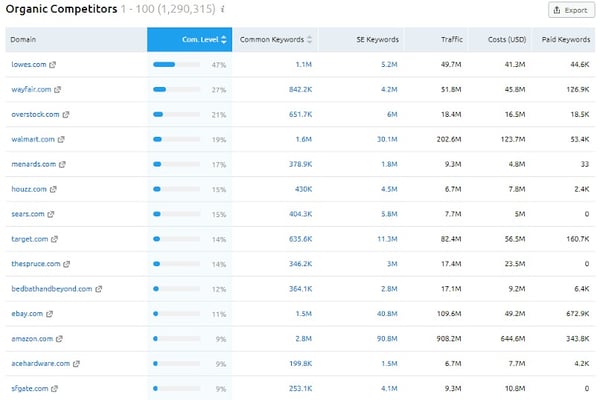7 Steps to Boost Your Ongoing SEO Strategy
Written by
They say the only constant in the universe is change, and that’s especially true when it comes to the world of SEO. Search Engine Optimization is ever-evolving to match pace with what the biggest search engine out there, Google, is changing about how inquiring minds find what they’re looking for.
To keep up to speed and ensure continued SEO success, you’ll need to have a solid strategy in place from the get-go, plus the flexibility to make adjustments over time.
With that, here are our top 7 steps to setting and adjusting your ongoing SEO content strategy to help get you the best results.
1. Set the Right Goals and KPIs
It all starts with your overall business goals. Why are you in business? Who are you here to serve? What need are you fulfilling?
From there, consider what you want your content to accomplish. Are you looking to:
- Generate traffic and build brand awareness?
- Stand out from the crowd with a unique take on a subject without regard to traffic?
- Turn site visitors into leads?
Set specific KPIs whose measurements will actually mean something for your goals. Know where the finish line is before you even get started, and make sure everyone — from the CEO to the Marketing Manager to the Content Writers — is on the same page.
Don’t just set KPIs and forget them! Keep track of your goals throughout the process. Document them and have them readily available for everyone to see and adjust as needed. To dive deeper into SEO KPIs, check out this article:
LEARN MORE: The ABCs of SEO KPIs: What, How, and How Often
2. Know Your Audience
Understand your audience, your prospects, and your customers. What questions do you anticipate? What questions have they already asked?
Before any keyword research is conducted, you must first fully understand what your audience and customers may search for and expect.
Be aware of any changes to their attitudes or questions. Put yourself in their shoes! Long gone are the days of stuffing keywords into your content as often as possible to get a high SERP listing. The algorithms have gotten far more advanced than that, such that they often look to understand a searcher’s intent, so your strategy truly needs to align with their needs.
3. Conduct Keyword Research
Once you know your audience and what you want your content to do, it’s time to dig into related topics and keywords people are searching for that are relevant to your audience and your business.
This might not always be easy to do, especially if you’re jumping into a market where you already have a lot of competitors. Some keywords are more difficult to rank for than others, though that doesn’t mean you should never try for those tougher ones!
Consider long-tail keywords, which are typically better targeted to bring in relevant traffic, rather than simpler keywords. For example, for a manufacturer of dumbbells for weightlifting, instead of “exercise equipment” for a keyword, a longer keyword such as “dumbbell weightlifting exercise equipment” will find traffic from people who specifically want weightlifting gear.
Plenty of tools exist for you to analyze which keywords may be best. You don’t always have to play a guessing game! Moz and Semrush are great for this purpose (and many others)!

LEARN MORE: How & Why to Monitor Keyword Rankings for Content Marketing Insights
4. Create Unique Content
After that’s all figured out, start creating relevant content that helps you achieve your business goals by genuinely helping your prospects and customers. Content that will serve people the way a competitor’s content can’t. Why should they consume your content and not your competitor’s? What kind of angle or value add can you put on an old keyword? What makes your product/service/company special and how does your content communicate that?
It’s important to remember that most traffic that comes to you from search engines is “top of funnel,” (ToFu) so your SEO content should not directly try to sell something. Your ToFu content creates content about topics relevant to your business that isn’t aimed at immediately closing a deal. Start or join a conversation! Establish yourself as an expert in what you’re offering. Google tends to appreciate that.
5. Measure Your Results
Before measuring your results, you need to know what you’ll be measuring. That’s why it’s important to have your goals established in the beginning so you won’t waste time tracking irrelevant metrics.
If you’re looking to generate more traffic and build awareness, for example, consider using Google Analytics and tracking your content traffic during a set period of time. If you see a steady increase over that time, that’s a good sign you’re achieving the goal.
By setting specific KPIs (see #1 above) in the beginning of your SEO content strategy, you’ll be better positioned once the content gets going to see hard data for analysis and apply the insights to adjust your content strategy and content optimization efforts.
Keyword strategy is only one piece of the SEO puzzle. Use our technical SEO checklist for specific activities and page updates to ensure your whole site is optimized for search engines so your targets can find you when they need you.
6. Understand What the Data is Telling You
With data in hand and plenty of content pieces created (so you have enough data to analyze), see how you’re measuring up against your goals. Data in four key areas may signal that a shift in SEO strategy is necessary.
Traffic
Looking at traffic numbers is one way to see if adjustments are needed — if getting traffic is your main goal. If you start seeing a dip in the amount of organic sessions, try to figure out why. What are your top performing content pieces, and have they dropped in rankings for important keywords? Are you still creating relevant content for your audience and goals or has the industry landscape shifted?
Lead Quality
Lead quality matters. If your goal is to generate more leads with your content — have you? If so, have they been good leads? Have they been prospects who are truly interested in making a purchase or learning more about your services? If your leads aren’t turning into customers, maybe there’s a problem with how you’re getting those leads in the first place.
Competitor Movement
Every business needs to keep an eye on what their peers and competitors are doing, and that includes their SEO strategies. Use a tool like Semrush for assessing your own SEO success as well as where your competitors stand with certain keywords.
Maybe you’re falling behind because your competitors have started ranking ahead of you for similar keywords. If that’s the case, where are you lacking? What can you do differently? Can you make adjustments to phrasing or other SEO tactics?
Keyword Saturation
It’s possible the keywords you’re using are already well established by competitors or larger businesses that have a real hold on them. Perhaps even related keywords are all dominated already and are going to be virtually impossible to rank for. This is where you may need to rethink which keywords can help you achieve your goals.
7. Know When Your SEO Strategy Needs Adjusting
If you’re finding you aren’t hitting your goals or aren’t moving the needle at all, it’s time to go back to the drawing board. Did you have the right SEO goals? Were you approaching them the right way? Look at the black and white data and have a good hard think about everything.
But it’s not just about the misses — it’s about the hits, too! In addition to making changes if things aren’t working, you should also evolve your strategy as you do meet your goals. Think, “What’s next?” Or, how can I capitalize on content that’s already moving up the search rankings to get more leads from the traffic I’m already getting?
RELATED: How to Conversion-Rate Optimize Web Forms for Best Lead Gen Results
If your first goal was to gain more traffic and you’re succeeding there on a regular basis, great! Now it’s time to advance to the next goal that makes sense. You have traffic under control, so where do you want to grow now?
If blogging is part of your content strategy and you have enough blogs on a given topic, consider creating a pillar page to give your visitors an overview of the topic and a hub of resources they can click on from there. Your visitors — and Google — will like that.
Go back to your goals and document your results, then document what direction you’re headed in next. Think of your goals as levels that can be achieved — with the caveat that you may one day need to revisit a goal you already met if it’s necessary.
SEO Survival Guide
We’re just scratching the surface of everything you need to think about with SEO. It’s a vast topic, but luckily for you, we have bunches of resources to help!
For a one-stop shop, check out our free SEO Survival Guide which you can bookmark and download a PDF copy, or browse all our blog articles on SEO here.
Subscribe To Our Blog
Information. Insights. Ideas. Get notified every time a new Weidert Group blog article is published – subscribe now!
You May Also Like...

Search Engine Optimization
Optimize Your Industrial Website for AI Search

Marketing Technology
Why Unified Data Efforts Fail (and How Manufacturers Can Fix It)

Search Engine Optimization
How Falcon Rebuilt Industrial AI Search Visibility in 2025
Accelerate Your Growth with
Weidert Group
If you’re ready to explore a partnership, request a personalized consultation with our team.


